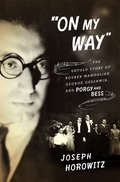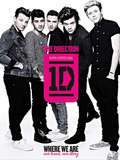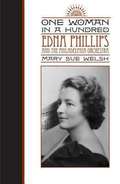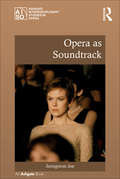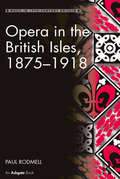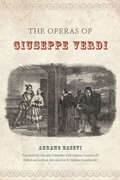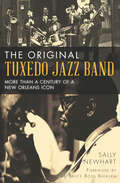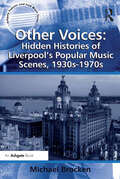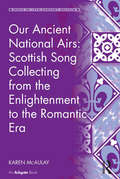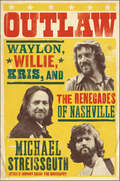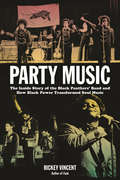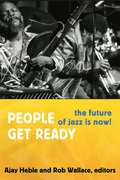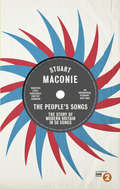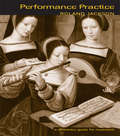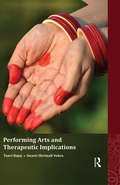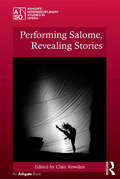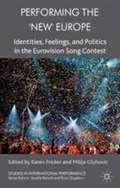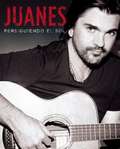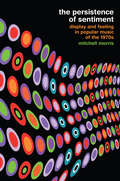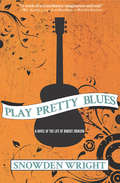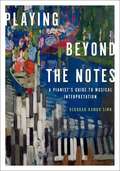- Table View
- List View
"On My Way": The Untold Story of Rouben Mamoulian, George Gershwin, and Porgy and Bess
by Joseph HorowitzA revelatory history of the operatic masterpiece that both made and destroyed Rouben Mamoulian, its director and unsung hero. "Bring my goat!" Porgy exclaims in the final scene of Gershwin's opera Porgy and Bess. Bess, whom he loves, has left for New York City, and he's determined to find her. When his request is met with astonishment--New York is a great distance from South Carolina's Catfish Row--Porgy remains undaunted. He mounts his goat-cart and leads the community in an ecstatic finale, "Oh Lawd, I'm on my way." Stephen Sondheim has called "Bring my goat!" "one of the most moving moments in musical theater history." For years it was assumed that DuBose Heyward--the author of the seminal novella and subsequent play, Porgy, and later the librettist for the opera Porgy and Bess--penned this historic line. In fact, both it and "Oh Lawd, I'm on my way" were added to the play eight years earlier by that production's unheralded architect: Rouben Mamoulian. Porgy and Bess as we know it would not exist without the contributions of this master director. Culling new information from the recently opened Mamoulian Archives at the Library of Congress, award-winning author Joseph Horowitz shows that, more than anyone else, Mamoulian took Heyward's vignette of a regional African-American subculture and transformed it into an epic theater work, a universal parable of suffering and redemption. Part biography, part revelatory history, "On My Way" re-creates Mamoulian's visionary style on stage and screen, his collaboration with George Gershwin, and the genesis of the opera that changed the face of American musical life.
One Direction: Where We Are
by One DirectionCalling all One Direction fans This is the only official book from 1D charting their journey over the last year and a half--from the places theyve visited and fans theyve met, to their thoughts and feelings, hopes and dreams, highs and lows. It has been a phenomenal year--and this is a phenomenal story. This Christmas, there will be no other book that true One Direction fans will want
One Woman in a Hundred: Edna Phillips and the Philadelphia Orchestra (Music in American Life)
by Mary Sue WelshGifted harpist Edna Phillips (1907–2003) joined the Philadelphia Orchestra in 1930, becoming not only that ensemble's first female member but also the first woman to hold a principal position in a major American orchestra. Plucked from the Curtis Institute of Music in the midst of her studies, Phillips was only twenty-three years old when Leopold Stokowski, one of the twentieth century's most innovative and controversial conductors, named her principal harpist. This candid, colorful account traces Phillips's journey through the competitive realm of Philadelphia's virtuoso players, where she survived--and thrived--thanks to her undeniable talent, determination, and lively humor. Drawing on extensive interviews with Phillips, her family, and colleagues as well as archival sources, One Woman in a Hundred chronicles the training, aspirations, setbacks, and successes of this pioneering woman musician. Mary Sue Welsh recounts numerous insider stories of rehearsal and performance with Stokowski and other renowned conductors of the period such as Arturo Toscanini, Fritz Reiner, Otto Klemperer, Sir Thomas Beecham, and Eugene Ormandy. She also depicts Phillips's interactions with fellow performers, the orchestra management, and her teacher, the wily and brilliant Carlos Salzedo. Blessed with a nimble wit, Phillips navigated a plethora of challenges, ranging from false conductors' cues to the advances of the debonair Stokowski and others. She remained with the orchestra through some of its most exciting years from 1930 to 1946 and was instrumental in fostering harp performance, commissioning many significant contributions to the literature. This portrait of Phillips's exceptional tenure with the Philadelphia Orchestra also reveals the behind-the-scenes life of a famous orchestra during a period in which Rachmaninoff declared it "the finest orchestra the world has ever heard." Through Phillips's perceptive eyes, readers will watch as Stokowski melds his musicians into a marvelously flexible ensemble; world-class performers reach great heights and make embarrassing flubs; Greta Garbo comes to Philadelphia to observe her lover Leopold Stokowski at work; and the orchestra encounters the novel experience of recording for Walt Disney's Fantasia. A colorful glimpse into a world-class orchestra at the height of its glory, One Woman in a Hundred tells the fascinating story of one woman brave enough and strong enough to overcome historic barriers and pursue her dreams.
Opera as Soundtrack (Ashgate Interdisciplinary Studies in Opera)
by Jeongwon JoeFilmmakers' fascination with opera dates back to the silent era but it was not until the late 1980s that critical enquiries into the intersection of opera and cinema began to emerge. Jeongwon Joe focusses primarily on the role of opera as soundtrack by exploring the distinct effects opera produces in film, effects which differ from other types of soundtrack music, such as jazz or symphony. These effects are examined from three perspectives: peculiar qualities of the operatic voice; various properties commonly associated with opera, such as excess, otherness or death; and multifaceted tensions between opera and cinema - for instance, opera as live, embodied, high art and cinema as technologically mediated, popular entertainment. Joe argues that when opera excerpts are employed on soundtracks they tend to appear at critical moments of the film, usually associated with the protagonists, and the author explores why it is opera, not symphony or jazz, that accompanies poignant scenes like these. Joe's film analysis focuses on the time period of the post-1970s, which is distinguished by an increase of opera excerpts on soundtracks to blockbuster titles, the commercial recognition of which promoted the production of numerous opera soundtrack CDs in the following years. Joe incorporates an empirical methodology by examining primary sources such as production files, cue-sheets and unpublished interviews with film directors and composers to enhance the traditional hermeneutic approach. The films analysed in her book include Woody Allen’s Match Point, David Cronenberg’s M. Butterfly, and Wong Kar-wai’s 2046.
Opera in the Age of Rousseau
by David CharltonHistorians of French politics, art, philosophy and literature have long known the tensions and fascinations of Louis XV's reign, the 1750s in particular. David Charlton's study comprehensively re-examines this period, from Rameau to Gluck and elucidates the long-term issues surrounding opera. Taking Rousseau's Le Devin du Village as one narrative centrepiece, Charlton investigates this opera's origins and influences in the 1740s and goes on to use past and present research to create a new structural model that explains the elements of reform in Gluck's tragédies for Paris. Charlton's book opens many new perspectives on the musical practices and politics of the period, including the Querelle des Bouffons. It gives the first detailed account of intermezzi and opere buffe performed by Eustachio Bambini's troupe at the Paris Opéra from August 1752 to February 1754 and discusses Rameau's comedies Platée and Les Paladins and their origins.
Opera in the British Isles, 1875-1918 (Music in Nineteenth-Century Britain)
by Paul RodmellWhile the musical culture of the British Isles in the 'long nineteenth century' has been reclaimed from obscurity by musicologists in the last thirty years, appraisal of operatic culture in the latter part of this period has remained largely elusive. Paul Rodmell argues that there were far more opportunities for composers, performers and audiences than one might expect, an assertion demonstrated by the fact that over one hundred serious operas by British composers were premiered between 1875 and 1918. Rodmell examines the nature of operatic culture in the British Isles during this period, looking at the way in which opera was produced and 'consumed' by companies and audiences, the repertory performed, social attitudes to opera, the dominance of London's West End and the activities of touring companies in the provinces, and the position of British composers within this realm of activity. In doing so, he uncovers the undoubted challenges faced by opera in Britain in this period, and delves further into why it was especially difficult to make a breakthrough in this particular genre when other fields of compositional endeavour were enjoying a period of sustained growth. Whilst contemporaneous composers and commentators and later advocates of British music may have felt that the country's operatic life did not measure up to their aspirations or ambitions, there was still a great deal of activity and, even if this was not necessarily that which was always desired, it had a significant and lasting impact on musical culture in Britain.
The Operas of Giuseppe Verdi
by Stefano Castelvecchi Abramo Basevi translated by Edward Schneider edited by Stefano CastelvecchiAbramo Basevi published his study of VerdiOCOs operas in Florence in 1859, in the middle of the composerOCOs career. The first thorough, systematic examination of VerdiOCOs operas, it covered the twenty works produced between 1842 and 1857OCofrom "Nabucco" and "Macbeth" to "Il trovatore," "La traviata," and "Aroldo. " But while BaseviOCOs work is still widely cited and discussedOCoand nowhere more so than in the English-speaking worldOCono translation of the entire volume has previously been available. "The Operas of Giuseppe Verdi "fills this gap, at the same time providing an invaluable critical apparatus and commentary on BaseviOCOs work. aAs a contemporary of Verdi and a trained musician, erudite scholar, and critic conversant with current and past operatic repertories, Basevi presented pointed discussion of the operas and their historical context, offering todayOCOs readers a unique window into many aspects of operatic culture, and culture in general, in VerdiOCOs Italy. He wrote with precision on formal aspects, use of melody and orchestration, and other compositional features, which made his study an acknowledged model for the growing field of music criticism. Carefully annotated and with an engaging introduction and detailed glossary by editor Stefano Castelvecchi, this translation illuminates BaseviOCOs musical and historical references as well as aspects of his language that remain difficult to grasp even for Italian readers. aMaking BaseviOCOs important contribution to our understanding of Verdi and his operas available to a broad audience for the first time, " The Operas of Giuseppe Verdi" will delight scholars and opera enthusiasts alike. "
The Orchestral Revolution
by Emily I. DolanThe Orchestral Revolution explores the changing listening culture of the eighteenth and early nineteenth centuries. Delving into Enlightenment philosophy, the nature of instruments, compositional practices and reception history, this book describes the birth of a new form of attention to sonority and uncovers the intimate relationship between the development of modern musical aesthetics and the emergence of orchestration. By focusing upon Joseph Haydn's innovative strategies of orchestration and tracing their reception and influence, Emily Dolan shows that the consolidation of the modern orchestra radically altered how people listened to and thought about the expressive capacity of instruments. The orchestra transformed from a mere gathering of instruments into an ideal community full of diverse, nuanced and expressive characters. In addressing this key moment in the history of music, Dolan demonstrates the importance of the materiality of sound in the formation of the modern musical artwork.
Orientalism and Musical Mission: Palestine and the West
by Rachel Beckles WillsonOrientalism and Musical Mission presents a new way of understanding music's connections with imperialism, drawing on new archive sources and interviews and using the lens of 'mission'. Rachel Beckles Willson demonstrates how institutions such as churches, schools, radio stations and governments, influenced by missions from Europe and North America since the mid-nineteenth century, have consistently claimed that music provides a way of understanding and reforming Arab civilians in Palestine. Beckles Willson discusses the phenomenon not only in religious and developmental aid circles where it has had strong currency, but also in broader political contexts. Plotting a historical trajectory from the late Ottoman and British Mandate eras to the present time, the book sheds new light on relations between Europe, the USA and the Palestinians, and creates space for a neglected Palestinian music history.
The Original Tuxedo Jazz Band: More Than a Century of a New Orleans Icon (Music Ser.)
by Sally NewhartA lively look at the long career of these legendary musicians, from a Storyville dance hall to the White House and beyond. In 1910, the Tuxedo Jazz Band played its first show at the Tuxedo Dance Hall in Storyville under Oscar Celestin. The popular ensemble would go on to play all over New Orleans, as well as across the South and the nation—and in 1953, it became the first jazz band to play the White House. The band has punctuated jazz history and produced some of the most memorable musicians of the past century: Bob French, Albert French, William Ridgley, Octave Crosby, Louis Armstrong, and more. Author Sally Newhart has written a definitive and captivating history of the band from inception to present, including oral histories, archival photos, a discography, and a previously unpublished complete list of members since 1910.
Orpheus in the Marketplace
by Tim Carter Richard A. GoldthwaiteThe Florentine musician Jacopo Peri (1561-1633) is known as the composer of the first operas--they include the earliest to survive complete, Euridice (1600), in which Peri sang the role of Orpheus. The recent discovery of a large number of private account books belonging to him and his family allows for a greater exploration of Peri's professional and personal life. Richard Goldthwaite, an economic historian, and Tim Carter, a musicologist, have done more, however, than write a biography: their investigation exposes the value of such financial documents as a primary source for an entire period. This record of Peri's wide-ranging investments and activities in the marketplace enables the first detailed account of the Florentine economy in the late sixteenth and early seventeenth centuries, and opens a new perspective on one of Europe's principal centers of capitalism. His economic circumstances reflect continuities and transformations in Florentine society, and the strategies for negotiating them, under the Medici grand dukes. They also allow a reevaluation of Peri the singer and composer that elucidates the cultural life of a major artistic center even in changing times, providing a quite different view of what it meant to be a musician in late Renaissance Italy.
Other Voices: Hidden Histories Of Liverpool's Popular Music Scenes 1930s-1970s (Ashgate Popular and Folk Music Series)
by Michael BrockenAt times it appears that a whole industry exists to perpetuate the myth of origin of the Beatles. There certainly exists a popular music (or perhaps 'rock') origin myth concerning this group and the city of Liverpool and this draws in devotees, as if on a pilgrimage, to Liverpool itself. Once 'within' the city, local businesses exist primarily to escort these pilgrims around several almost iconic spaces and places associated with the group. At times it all almost seems 'spiritual'. One might argue however that, like any function myth, the music history of the Liverpool in which the Beatles grew and then departed is not fully represented. Beatles historians and businessmen-alike have seized upon myriad musical experiences and reworked them into a discourse that homogenizes not only the diverse collective articulations that initially put them into place, but also the receptive practices of those travellers willing to listen to a somewhat linear, exclusive narrative. Other Voices therefore exists as a history of the disparate and now partially hidden musical strands that contributed to Liverpool's musical countenance. It is also a critique of Beatles-related institutionalized popular music mythology. Via a critical historical investigation of several thus far partially hidden popular music activities in pre- and post-Second World War Liverpool, Michael Brocken reveals different yet intrinsic musical and socio-cultural processes from within the city of Liverpool. By addressing such 'scenes' as those involving dance bands, traditional jazz, folk music, country and western, and rhythm and blues, together with a consideration of partially hidden key places and individuals, and Liverpool's first 'real' record label, an assemblage of 'other voices' bears witness to an 'other', seldom discussed, Liverpool. By doing so, Brocken - born and raised in Liverpool - asks questions about not only the historicity of the Beatles-Liverpool narrative, but also about the absence o
Our Ancient National Airs: Scottish Song Collecting From The Enlightenment To The Romantic Era (Music in Nineteenth-Century Britain)
by Karen McAulayOne of the earliest documented Scottish song collectors actually to go 'into the field' to gather his specimens, was the Highlander Joseph Macdonald. Macdonald emigrated in 1760 - contemporaneously with the start of James Macpherson's famous but much disputed Ossian project - and it fell to the Revd. Patrick Macdonald to finish and subsequently publish his younger brother's collection. Karen McAulay traces the complex history of Scottish song collecting, and the publication of major Highland and Lowland collections, over the ensuing 130 years. Looking at sources, authenticity, collecting methodology and format, McAulay places these collections in their cultural context and traces links with contemporary attitudes towards such wide-ranging topics as the embryonic tourism and travel industry; cultural nationalism; fakery and forgery; literary and musical creativity; and the move from antiquarianism and dilettantism towards an increasingly scholarly and didactic tone in the mid-to-late Victorian collections. Attention is given to some of the performance issues raised, either in correspondence or in the paratexts of published collections; and the narrative is interlaced with references to contemporary literary, social and even political history as it affected the collectors themselves. Most significantly, this study demonstrates a resurgence of cultural nationalism in the late nineteenth century.
Outlaw: Waylon, Willie, Kris, and the Renegades of Nashville
by Michael StreissguthOutlaw by acclaimed author Michael Streissguth follows the stories of three legends as they redefined country music: Waylon Jennings, Willie Nelson, and Kris Kristofferson.Streissguth delves into the country music scene in the late '60s and early '70s, when these rebels found themselves in Music City writing songs and vying for record deals. Channeling the unrest of the times, all three Country Music Hall of Famers resisted the music industry’s unwritten rules and emerged as leaders of the outlaw movement that ultimately changed the recording industry.Outlaw offers a broad portrait of the outlaw movement in Nashville that includes a diverse secondary cast of characters, such as Johnny Cash, Rodney Crowell, Kinky Friedman, and Billy Joe Shaver, among others.With archival photographs throughout, Outlaw is a comprehensive examination of a fascinating shift in country music, and the three unbelievably talented musicians who forged the way.
Party Music: The Inside Story of the Black Panthers' Band and How Black Power Transformed Soul Music
by Boots Riley Rickey VincentExamining the culture and politics of the Black Power era of the late 1960s, this book explores the relationship of soul music to the Black Power movement from the vantage point of the musicians and black revolutionaries themselves. The 1960s were a turbulent time for race relations in the United States, but no other area in the country epitomized the radical social change that was taking place more than the San Francisco Bay Area--the epicenter of the Black Panthers movement. This social history introduces fans of soul music and 20th-century U.S. history enthusiasts to the Black Panthers' own band, the Lumpen, a group comprised of rank-and-file members of the Oakland, California-based Party. During their year-long tenure, the Lumpen produced hard-driving rhythm-and-blues that asserted the revolutionary ideology of the Black Panthers. Through his rediscovery of the Lumpen, and based on new interviews with Party and band members, author Rickey Vincent provides an insider's account of Black Power politics and soul music aesthetics in an original narrative that reveals more detail about the Black Revolution than ever before.
People Get Ready: The Future of Jazz Is Now!
by Heble Ajay Wallace RobIn People Get Ready, musicians, scholars, and journalists write about jazz since 1965, the year that Curtis Mayfield composed the famous civil rights anthem that gives this collection its title. The contributors emphasize how the political consciousness that infused jazz in the 1960s and early 1970s has informed jazz in the years since then. They bring nuance to historical accounts of the avant-garde, the New Thing, Free Jazz, "non-idiomatic" improvisation, fusion, and other forms of jazz that have flourished since the 1960s, and they reveal the contemporary relevance of those musical practices. Many of the participants in the jazz scenes discussed are still active performers. A photographic essay captures some of them in candid moments before performances. Other pieces revise standard accounts of well-known jazz figures, such as Duke Ellington, and lesser-known musicians, including Jeanne Lee; delve into how money, class, space, and economics affect the performance of experimental music; and take up the question of how digital technology influences improvisation. People Get Ready offers a vision for the future of jazz based on an appreciation of the complexity of its past and the abundance of innovation in the present. Contributors. Tamar Barzel, John Brackett, Douglas Ewart, Ajay Heble, Vijay Iyer, Thomas King, Tracy McMullen, Paul D. Miller/DJ Spooky, Nicole Mitchell, Roscoe Mitchell, Famoudou Don Moye, Aldon Lynn Nielsen, Eric Porter, Marc Ribot, Matana Roberts, Jaribu Shahid, Julie Dawn Smith, Wadada Leo Smith, Alan Stanbridge, John Szwed, Greg Tate, Scott Thomson, Rob Wallace, Ellen Waterman, Corey Wilkes
The People’s Songs: The Story of Modern Britain in 50 Records
by Stuart MaconieThese are the songs that we have listened to, laughed to, loved to and laboured to, as well as downed tools and danced to. Covering the last seven decades, Stuart Maconie looks at the songs that have sound tracked our changing times, and – just sometimes – changed the way we feel. Beginning with Vera Lynn’s ‘We’ll Meet Again’, a song that reassured a nation parted from their loved ones by the turmoil of war, and culminating with the manic energy of ‘Bonkers’, Dizzee Rascal’s anthem for the push and rush of the 21st century inner city, The People’s Songs takes a tour of our island’s pop music, and asks what it means to us. This is not a rock critique about the 50 greatest tracks ever recorded. Rather, it is a celebration of songs that tell us something about a changing Britain during the dramatic and kaleidoscopic period from the Second World War to the present day. Here are songs about work, war, class, leisure, race, family, drugs, sex, patriotism and more, recorded in times of prosperity or poverty. This is the music that inspired haircuts and dance crazes, but also protest and social change. The companion to Stuart Maconie’s landmark Radio 2 series, The People’s Songs shows us the power of ‘cheap’ pop music, one of Britain’s greatest exports. These are the songs we worked to and partied to, and grown up and grown old to – from ‘A Whiter Shade of Pale’ to ‘Rehab', ‘She Loves You’ to ‘Star Man’, ‘Dedicated Follower of Fashion’ to ‘Radio Ga Ga’.
Performance Practice: A Dictionary-Guide for Musicians
by Roland JacksonPerformance practice is the study of how music was performed over the centuries, both by its originators (the composers and performers who introduced the works) and, later, by revivalists. This first of its kind Dictionary offers entries on composers, musiciansperformers, technical terms, performance centers, musical instruments, and genres, all aimed at elucidating issues in performance practice. This A-Z guide will help students, scholars, and listeners understand how musical works were originally performed and subsequently changed over the centuries. Compiled by a leading scholar in the field, this work will serve as both a point-of-entry for beginners as well as a roadmap for advanced scholarship in the field.
Performing Arts and Therapeutic Implications
by Tanvi Bajaj Swasti Shrimali VohraPresenting an alternative perspective, this book proposes that performing arts forge an emotional bond between the performer and the audience, making the act of performance a therapeutic and restorative experience, and not merely recreational. Studying the life-experiences of six artists, and their unique engagement with three art forms — music, drama and dance — the book highlights the physical, emotional, mental, and spiritual effects of performing arts both on the performers and the audience. More importantly, it takes the current understanding of the therapeutic role of arts beyond a deficit model of health that focuses on their use in curing illnesses, disabilities and imbalances, towards a more positive growth-centric model that relates them to promoting holistic mental health, well-being and happiness. It thus bridges the gap between the theoretical understanding of creative arts therapy and the practical experience of performing arts in non-therapeutic settings. Further, it assumes increasing relevance with respect to fast-changing lifestyles to which stress and ill-health are often attributed. The book will appeal to artists, educators and researchers of performing arts, applied psychology, counselling and therapy, and cultural studies, as well as interested general readers.
Performing Salome, Revealing Stories (Ashgate Interdisciplinary Studies in Opera)
by Clair RowdenWith its first public live performance in Paris on 11 February 1896, Oscar Wilde's Salomé took on female embodied form that signalled the start of 'her' phenomenal journey through the history of the arts in the twentieth century. This volume explores Salome's appropriation and reincarnation across the arts - not just Wilde's heroine, nor Richard Strauss's - but Salome as a cultural icon in fin-de-siècle society, whose appeal for ever new interpretations of the biblical story still endures today. Using Salome as a common starting point, each chapter suggests new ways in which performing bodies reveal alternative stories, narratives and perspectives and offer a range and breadth of source material and theoretical approaches. The first chapter draws on the field of comparative literature to investigate the inter-artistic interpretations of Salome in a period that straddles the end of the nineteenth century and the beginning of the Modernist era. This chapter sets the tone for the rest of the volume, which develops specific case studies dealing with censorship, reception, authorial reputation, appropriation, embodiment and performance. As well as the Viennese premiere of Wilde's play, embodied performances of Salome from the period before the First World War are considered, offering insight into the role and agency of performers in the production and complex negotiation of meaning inherent in the role of Salome. By examining important productions of Strauss's Salome since 1945, and more recent film interpretations of Wilde's play, the last chapters explore performance as a cultural practice that reinscribes and continuously reinvents the ideas, icons, symbols and gestures that shape both the performance itself, its reception and its cultural meaning.
Performing the 'New' Europe
by Karen Fricker Milija GluhovicThis fascinating and lively volume makes the case that the Eurovision Song Contest is an arena for European identification in which both national solidarity and participation in a European identity are confirmed, and a site where cultural struggles over the meanings, frontiers and limits of Europe are enacted.
Persiguiendo el sol
by Juanes"Yo, por mi lado, cumplo con hacer lo que creo que he venido a hacer al mundo: tocar y componer música buscando con ello despertar conciencias, renovar corazones y generar un cambio. Seguiré mirando las estrellas y viajando por el mundo hasta que Dios me lo permita. Ojalá pueda seguir por muchos años más conectando vidas a través del arte, tocando mi guitarra y persiguiendo el sol". --Juanes En Persiguiendo el sol el ícono humanitario y estrella internacional de la música comparte la increíble historia de su vida y de cómo la música y la fe lo han guiado en su camino. En sus propias palabras y con deslumbrantes fotografías --algunas nunca antes vistas-- Juanes habla de sus momentos más definitivos, desde su infancia hasta el presente, reflexionando acerca de su camino espiritual y musical y sobre las experiencias personales y profesionales que lo han convertido en el hombre que es hoy. Juanes nació y se crió en Colombia. De su familia heredó un gran amor por la música y aprendió a tocar la guitarra desde pequeño. A los dieciséis años se convirtió en miembro fundador, cantante, guitarrista y compositor de Ekhymosis, que llegó a ser uno de los grupos de rock más famosos de Colombia. Sin embargo, fue su carrera como solista la que lo propulsó al estrellato internacional. Con gran honestidad, Juanes cuenta cómo sus momentos de gloria estuvieron muchas veces plagados de incertidumbre e introspección, y cómo el hecho de mantenerse fiel a sus creencias y apasionado por su arte le dio la fuerza y la visión para reinventarse. Mientras que su vida como artista ha sido ampliamente documentada, el Juanes más privado jamás se ha revelado en sus propias palabras... hasta ahora.
The Persistence of Sentiment: Display and Feeling in Popular Music of the 1970s
by Mitchell MorrisHow can we account for the persistent appeal of glossy commercial pop music? Why do certain performers have such emotional power, even though their music is considered vulgar or second rate? In The Persistence of Sentiment, Mitchell Morris gives a critical account of a group of American popular music performers who have dedicated fan bases and considerable commercial success despite the critical disdain they have endured. Morris examines the specific musical features of some exemplary pop songs and draws attention to the social contexts that contributed to their popularity as well as their dismissal. These artists were all members of more or less disadvantaged social categories: members of racial or sexual minorities, victims of class and gender prejudices, advocates of populations excluded from the mainstream. The complicated commercial world of pop music in the 1970s allowed the greater promulgation of musical styles and idioms that spoke to and for exactly those stigmatized audiences. In more recent years, beginning with the "Seventies Revival" of the early 1990s, additional perspectives and layers of interpretation have allowed not only a deeper understanding of these songs' function than when they were first popular, but also an appreciation of how their significance has shifted for American listeners in the succeeding three decades.
Play Pretty Blues
by Snowden WrightThe mysteries of blues legend Robert Johnson's live and death long ago became myth. Part researched reconstruction, part vivid imagination, this lyrical novel brings Johnson alive through the voices of his six wives, revealing the husband and son inside the legend, illuminating the vacuum Johnson left in the worlds of those who loved him and those he would never meet.
Playing Beyond The Notes: A Pianist's Guide to Musical Interpretation
by Deborah Rambo SinnThis book demystifies the complex topic of musical interpretation by boiling it down to basic principles in an accessible writing style. The book targets pianists, piano teachers, and piano pedagogy students and incorporates over 200 musical examples from the intermediate and advanced piano repertoire.
